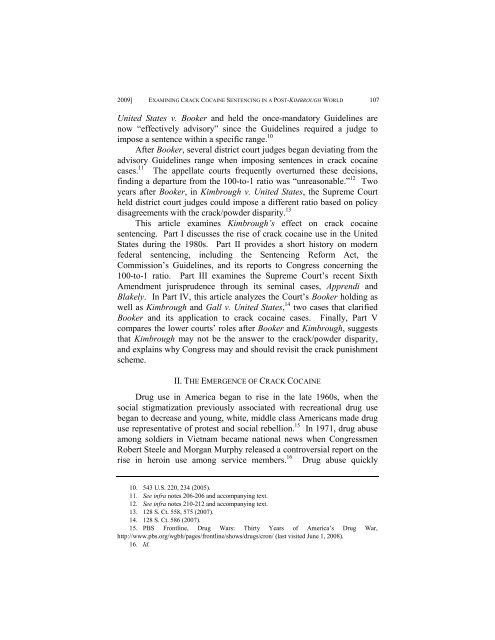Examining Crack Cocaine Sentencing in a Post- Kimbrough World
Examining Crack Cocaine Sentencing in a Post- Kimbrough World
Examining Crack Cocaine Sentencing in a Post- Kimbrough World
You also want an ePaper? Increase the reach of your titles
YUMPU automatically turns print PDFs into web optimized ePapers that Google loves.
08-CASSIDY.DOC<br />
1/29/2009 3:29:23 PM<br />
2009] EXAMINING CRACK COCAINE SENTENCING IN A POST-KIMBROUGH WORLD 107<br />
United States v. Booker and held the once-mandatory Guidel<strong>in</strong>es are<br />
now “effectively advisory” s<strong>in</strong>ce the Guidel<strong>in</strong>es required a judge to<br />
impose a sentence with<strong>in</strong> a specific range. 10<br />
After Booker, several district court judges began deviat<strong>in</strong>g from the<br />
advisory Guidel<strong>in</strong>es range when impos<strong>in</strong>g sentences <strong>in</strong> crack coca<strong>in</strong>e<br />
cases. 11 The appellate courts frequently overturned these decisions,<br />
f<strong>in</strong>d<strong>in</strong>g a departure from the 100-to-1 ratio was “unreasonable.” 12 Two<br />
years after Booker, <strong>in</strong> <strong>Kimbrough</strong> v. United States, the Supreme Court<br />
held district court judges could impose a different ratio based on policy<br />
disagreements with the crack/powder disparity. 13<br />
This article exam<strong>in</strong>es <strong>Kimbrough</strong>’s effect on crack coca<strong>in</strong>e<br />
sentenc<strong>in</strong>g. Part I discusses the rise of crack coca<strong>in</strong>e use <strong>in</strong> the United<br />
States dur<strong>in</strong>g the 1980s. Part II provides a short history on modern<br />
federal sentenc<strong>in</strong>g, <strong>in</strong>clud<strong>in</strong>g the <strong>Sentenc<strong>in</strong>g</strong> Reform Act, the<br />
Commission’s Guidel<strong>in</strong>es, and its reports to Congress concern<strong>in</strong>g the<br />
100-to-1 ratio. Part III exam<strong>in</strong>es the Supreme Court’s recent Sixth<br />
Amendment jurisprudence through its sem<strong>in</strong>al cases, Apprendi and<br />
Blakely. In Part IV, this article analyzes the Court’s Booker hold<strong>in</strong>g as<br />
well as <strong>Kimbrough</strong> and Gall v. United States, 14 two cases that clarified<br />
Booker and its application to crack coca<strong>in</strong>e cases. F<strong>in</strong>ally, Part V<br />
compares the lower courts’ roles after Booker and <strong>Kimbrough</strong>, suggests<br />
that <strong>Kimbrough</strong> may not be the answer to the crack/powder disparity,<br />
and expla<strong>in</strong>s why Congress may and should revisit the crack punishment<br />
scheme.<br />
II. THE EMERGENCE OF CRACK COCAINE<br />
Drug use <strong>in</strong> America began to rise <strong>in</strong> the late 1960s, when the<br />
social stigmatization previously associated with recreational drug use<br />
began to decrease and young, white, middle class Americans made drug<br />
use representative of protest and social rebellion. 15 In 1971, drug abuse<br />
among soldiers <strong>in</strong> Vietnam became national news when Congressmen<br />
Robert Steele and Morgan Murphy released a controversial report on the<br />
rise <strong>in</strong> hero<strong>in</strong> use among service members. 16 Drug abuse quickly<br />
10. 543 U.S. 220, 234 (2005).<br />
11. See <strong>in</strong>fra notes 206-206 and accompany<strong>in</strong>g text.<br />
12. See <strong>in</strong>fra notes 210-212 and accompany<strong>in</strong>g text.<br />
13. 128 S. Ct. 558, 575 (2007).<br />
14. 128 S. Ct. 586 (2007).<br />
15. PBS Frontl<strong>in</strong>e, Drug Wars: Thirty Years of America’s Drug War,<br />
http://www.pbs.org/wgbh/pages/frontl<strong>in</strong>e/shows/drugs/cron/ (last visited June 1, 2008).<br />
16. Id.
















